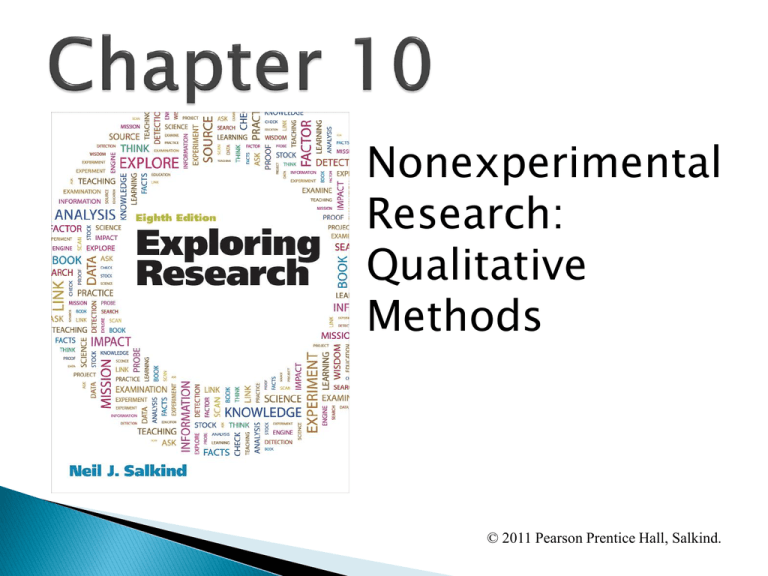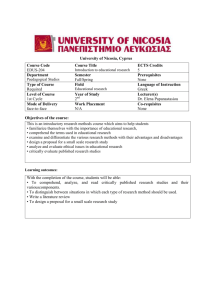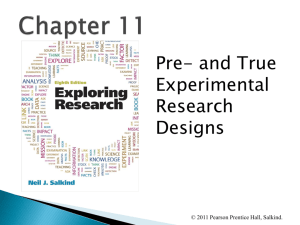
Nonexperimental
Research:
Qualitative
Methods
© 2011 Pearson Prentice Hall, Salkind.
Explain the difference between
qualitative and quantitative research.
Discuss the different types of research
sources that are regularly used in
qualitative research.
List the advantages and disadvantages
of the case study method.
List four ways ethnographies differ from
case studies.
© 2011 Pearson Prentice Hall, Salkind.
List six steps involved in historical
research.
Discuss primary and secondary sources.
Given an historical data source, identify
whether the source is primary or
secondary.
Explain why authenticity and accuracy
are important to historical research.
Discuss internal and external criticisms
of historical research.
© 2011 Pearson Prentice Hall, Salkind.
Conducting
Research
Case
Qualitative Research
Sources
Studies
Ethnographies
Historical
Research
Qualitative
Research Tools
© 2011 Pearson Prentice Hall, Salkind.
© 2011 Pearson Prentice Hall, Salkind.
Qualitative
research
◦ Uses descriptions rather than numerical
measurements of behavior
◦ Asks different kinds of questions
© 2011 Pearson Prentice Hall, Salkind.
© 2011 Pearson Prentice Hall, Salkind.
Documents
are often saved to
provide a record for later use
◦ Public documents are usually readily
available
◦ Availability of internal documents may be
restricted
© 2011 Pearson Prentice Hall, Salkind.
Provide descriptive data about an
organization
Can be a “gold mine” of useful
information
© 2011 Pearson Prentice Hall, Salkind.
Physical
traces that are usually not
purposely left behind
Can
provide insight into behavior
that cannot be observed directly
© 2011 Pearson Prentice Hall, Salkind.
Researchers
actually watch the
behavior of interest
Usually
unobtrusive—the
researcher does not interfere with
or participate in the behavior
© 2011 Pearson Prentice Hall, Salkind.
Observers
are members of the
group being observed
Observers
can become biased—
maintaining objectivity is essential
© 2011 Pearson Prentice Hall, Salkind.
Focus groups are formed to address
specific issues
A focus group has four main functions:
◦ Gather information
◦ Generate insight
◦ Understand how a group’s members reach
decisions
◦ Encourage interaction
© 2011 Pearson Prentice Hall, Salkind.
© 2011 Pearson Prentice Hall, Salkind.
Study
one (or a few) persons,
institutions, or events
Are
designed to gather as much
detail about a subject as possible
© 2011 Pearson Prentice Hall, Salkind.
Limited focus allows detailed
examination of subject
Use several different techniques to
gather data
Best way to gather detailed information
about subject
Can suggest directions for future
research
© 2011 Pearson Prentice Hall, Salkind.
Time-consuming
Subject to biases in observing and
recording data
Lack breadth
Cannot demonstrate cause-and-effect
relationships
Limited generalizability
© 2011 Pearson Prentice Hall, Salkind.
© 2011 Pearson Prentice Hall, Salkind.
A
good way to study a culture
Provide
subject
rich detail about their
© 2011 Pearson Prentice Hall, Salkind.
The holistic perspective is more concerned
with the “big picture”
◦ Looks at the entire group’s behavior rather than
at individual behaviors
Frequently uses participant observation
Ethnographers avoid proposing hypotheses
◦ Researchers begin with only enough information
to “fit in”
© 2011 Pearson Prentice Hall, Salkind.
© 2011 Pearson Prentice Hall, Salkind.
“Those
who forget the past are
condemned to repeat it!”
(George Santayana, 1905)
Historical
research is also called
historiography
© 2011 Pearson Prentice Hall, Salkind.
Define a topic
Form a hypothesis
Decide on useful and appropriate sources
Determine how to evaluate evidence
Integrate and synthesize data
Interpret results with reference to the
original hypothesis
© 2011 Pearson Prentice Hall, Salkind.
Primary
sources
◦ Originate with the people or animals actually
involved in the historical event
◦ Are direct results of the historical event
© 2011 Pearson Prentice Hall, Salkind.
Secondary
sources
◦ Are at least “once removed” from the
historical event
◦ Result from “after-the-fact” reports of an
historical event
© 2011 Pearson Prentice Hall, Salkind.
Authenticity
or external criticism
asks whether data originated as
described
◦ Did the person who signed a document
actually write it?
◦ Was an artifact found where it was left, or
was it “planted” or moved?
© 2011 Pearson Prentice Hall, Salkind.
Authenticity
or internal criticism
asks whether the source of the
data was objective and
trustworthy
◦ Do archival documents “fairly” represent
what actually happened?
◦ Do surviving artifacts adequately reflect an
entire culture or only a small part of it?
© 2011 Pearson Prentice Hall, Salkind.
Generalizability
is limited
Data are not observed by trained
observers, and so may be
questioned
Time-consuming
Evaluated by different criteria than
quantitative research
© 2011 Pearson Prentice Hall, Salkind.
© 2011 Pearson Prentice Hall, Salkind.
Help
manage large, qualitative data
sets
Enable
Link
plain text analysis
between documents
Search
Code
documents
and analyze data
© 2011 Pearson Prentice Hall, Salkind.
Explain the difference between qualitative
and quantitative research?
Discuss the different types of research
sources that are regularly used in
qualitative research?
List the advantages and disadvantages of
the case study method?
List four ways ethnographies differ from
case studies?
© 2011 Pearson Prentice Hall, Salkind.
List six steps involved in historical research?
Discuss primary and secondary sources?
Given an historical data source, identify
whether the source is primary or secondary?
Explain why authenticity and accuracy are
important to historical research?
Discuss internal and external criticisms of
historical research?
© 2011 Pearson Prentice Hall, Salkind.









